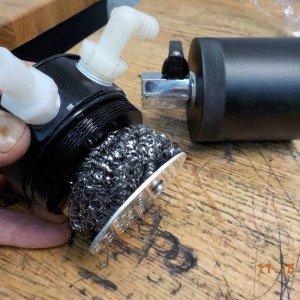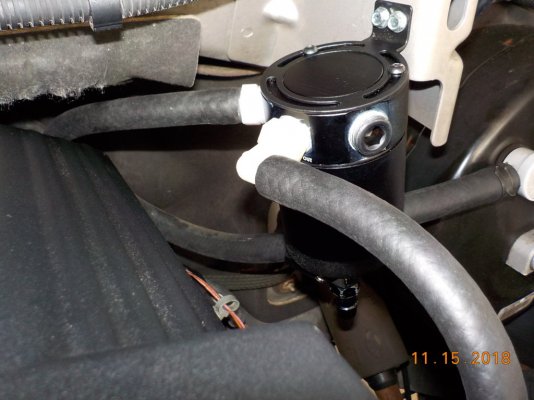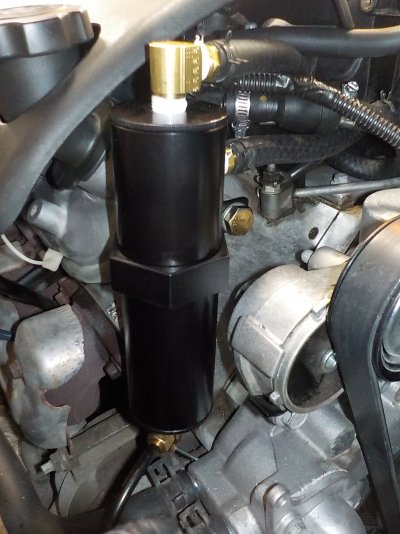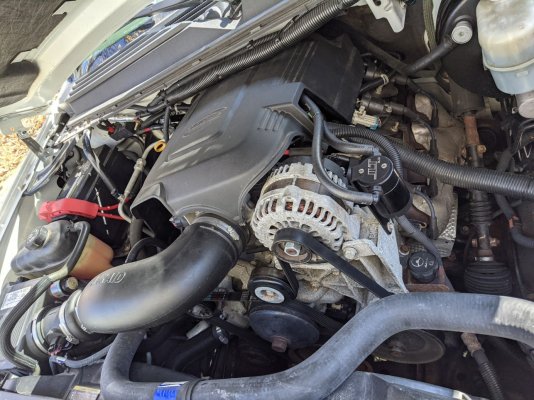iamdub
Full Access Member
First off, this is more of a universal discussion and not exclusive to the '07-'14. I couldn't decide where else would be appropriate so I just picked the GMT900 forum. Mods, feel free to move it if there's a better place for it.
I have an average Amazon catch can slated for installation on a friend's Tahoe. I'll be modding it, making a mounting bracket and getting the hoses made up so it'll be a quick install on his. I'll use my '08 as a template since his Tahoe is an '09. In the process, I'll take pics to use in a how-to for these these- mounting, connecting, modding, etc.
In checking over this catch can, I noticed the "IN" and "OUT" ports seem to be opposite of the way my $100 catchcans.com can is oriented. With that one, the dirty air comes in and goes straight into the filters, baffles, etc. The filters drip the oil into the can's reservoir and the scrubbed air then exits the can through an unrestricted port. In the Amazon one, the inlet is the unrestricted port that feeds the reservoir then the air travels through the baffle, filtration media, etc. before exiting.
This is the can off Amazon, representative of most any other one:
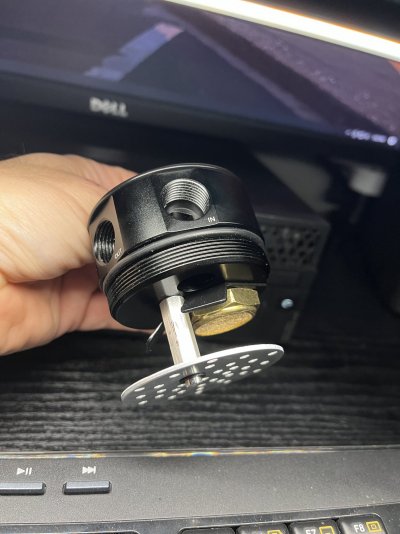
If connected per the labels, the oily air comes in through that port with the small metal flap and fills the reservoir. The flow continues up through the baffle then the bronze filter then out of the can and on towards the intake manifold. Picturing the direction of air flow, the oil droplets collecting on the filter would have to drip against the direction of flow.
Referencing the catch can in my sig pic, from catchcans.com, the dirty air from the valve cover enters into the top center where it immediately hits one of a few stages of filtration then continues into the reservoir then up through the port in the side to go to the intake manifold.
Really, it seems they'd work fine either way. But one of the two ways has to be better than the other for some reason. This is what I wanna discuss. I'll be adding a stainless steel scouring pad to it for extra filtration media. But that's irrelevant in this convo.
My thoughts: These things work by coalescing. Hitting the filter first to stall the air so the oil droplets can collide and coalesce makes sense to me. The engine's suction will pull the oil through the filter. The oil slowly making its way through will (eventually) drip down into the reservoir as the air that gets through the filtration media more easily continues on through the unrestricted port. I read where some people said that this would keep the oil in hose coming from the engine. My response to that is "And?" The oil was in the engine in the first place, why wouldn't you want it to stay? It's not gonna fill the hose and plug off the flow of PCV. If it went into the can then was filtered on the way out, I guess the filtering effectiveness would be about the same. But, the reservoir might get more oil in it, which is that much more oil removed from the engine rather than remaining in it, under the valve cover where it can drain back into the crankcase.
After spelling out my thoughts here, I'm now thinking that either way would be fine for scrubbing the air. But if you need to actually remove stuff, like moisture, you'd hook it up as the ports are labeled. If you just wanna scrub the air to get the oil out of it, you'd hook it up in reverse. I've never drained anything but a few ounces of oil from mine. No milkshake (no moisture). So, I'd wanna keep as much inside the engine as possible. If my thoughts are correct, then I can leave mine hooked up as it is and I'll set up my friend's can in the same "backwards" direction of flow.
Your turn.
I have an average Amazon catch can slated for installation on a friend's Tahoe. I'll be modding it, making a mounting bracket and getting the hoses made up so it'll be a quick install on his. I'll use my '08 as a template since his Tahoe is an '09. In the process, I'll take pics to use in a how-to for these these- mounting, connecting, modding, etc.
In checking over this catch can, I noticed the "IN" and "OUT" ports seem to be opposite of the way my $100 catchcans.com can is oriented. With that one, the dirty air comes in and goes straight into the filters, baffles, etc. The filters drip the oil into the can's reservoir and the scrubbed air then exits the can through an unrestricted port. In the Amazon one, the inlet is the unrestricted port that feeds the reservoir then the air travels through the baffle, filtration media, etc. before exiting.
This is the can off Amazon, representative of most any other one:

If connected per the labels, the oily air comes in through that port with the small metal flap and fills the reservoir. The flow continues up through the baffle then the bronze filter then out of the can and on towards the intake manifold. Picturing the direction of air flow, the oil droplets collecting on the filter would have to drip against the direction of flow.
Referencing the catch can in my sig pic, from catchcans.com, the dirty air from the valve cover enters into the top center where it immediately hits one of a few stages of filtration then continues into the reservoir then up through the port in the side to go to the intake manifold.
Really, it seems they'd work fine either way. But one of the two ways has to be better than the other for some reason. This is what I wanna discuss. I'll be adding a stainless steel scouring pad to it for extra filtration media. But that's irrelevant in this convo.
My thoughts: These things work by coalescing. Hitting the filter first to stall the air so the oil droplets can collide and coalesce makes sense to me. The engine's suction will pull the oil through the filter. The oil slowly making its way through will (eventually) drip down into the reservoir as the air that gets through the filtration media more easily continues on through the unrestricted port. I read where some people said that this would keep the oil in hose coming from the engine. My response to that is "And?" The oil was in the engine in the first place, why wouldn't you want it to stay? It's not gonna fill the hose and plug off the flow of PCV. If it went into the can then was filtered on the way out, I guess the filtering effectiveness would be about the same. But, the reservoir might get more oil in it, which is that much more oil removed from the engine rather than remaining in it, under the valve cover where it can drain back into the crankcase.
After spelling out my thoughts here, I'm now thinking that either way would be fine for scrubbing the air. But if you need to actually remove stuff, like moisture, you'd hook it up as the ports are labeled. If you just wanna scrub the air to get the oil out of it, you'd hook it up in reverse. I've never drained anything but a few ounces of oil from mine. No milkshake (no moisture). So, I'd wanna keep as much inside the engine as possible. If my thoughts are correct, then I can leave mine hooked up as it is and I'll set up my friend's can in the same "backwards" direction of flow.
Your turn.

